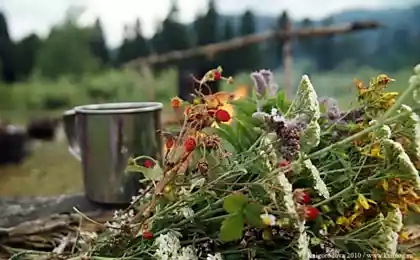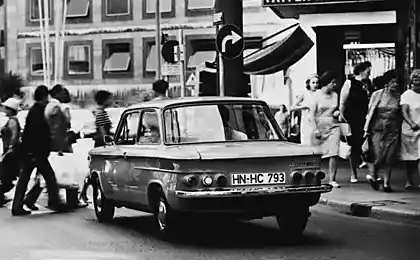801
Seven traditional Russian brands
All work praises the master - it's hard not to agree, looking at the "branded" items Russian masters, who have taken to heart not only at home, but also liked far beyond ...
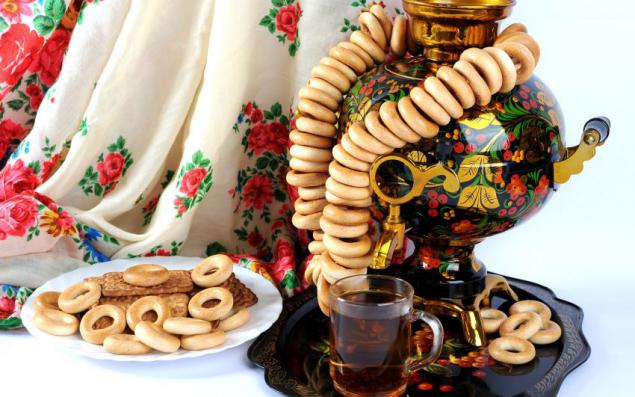
Dymkovo toy
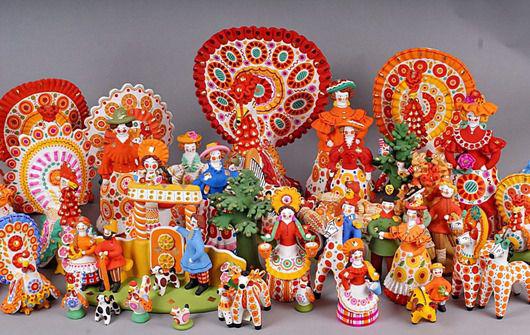
Bright and elegant Dymkovo toy became a symbol of Vyatka land. This is one of the oldest Russian crafts, which are engaged in Vyatskie master has for 400 years. The emergence of toys associated with the spring holiday to Whistler when out of the hands of women Dymkovo settlement out of clay whistles in the form of a sheep, konyashek, goats or ducks.
In 30-ies of XX century there was not only a large number of variations on the theme of spring toys and household fairy stories, but we developed a lot of new patterns and color combinations. Each toy - is unique and unique, because it molded and sign master each time. In the analog world, this clay there is no miracle.

Orenburg shawl

This thing is unmatched fit and goat fluff of cotton, silk or other filaments that make up its foundation. Knit from down in Orenburg began in the XVIII century. Abroad, the first Orenburg shawl was presented in 1857 at the Paris International Exhibition. Beauty and grace conquered the European audience.
The French in XVIII-XIX century, tens of thousands of pounds of imported Orenburg down, which is raised above Kashmir. Shawl, "spider" and stole - the three main varieties of Orenburg shawls. The main criteria of quality - a scarf should pass through the ring and placed in a goose egg. Top "webs" Today knit villages Shishma and Yellow Saraktash area.

Ural malachite

Despite the fact that malachite mined not only in the Urals, this green mineral with unique design is considered "Russian" rock, because that's Ural malachite superior to the others in its grandeur, "on the surface, like velvet, and a break as an atlas." From the Urals went and common throughout the world stone processing machines, called "Russian Mosaic". Loved present malachite product and Russian tsars. So, Napoleon, Alexander I gave the table a vase and candelabra, izgotovlnyee malachite. Unfortunately, in the Urals almost no true masters, able to create masterpieces, like vases and Galberga Shtakenshnejdera, tabletops Montferrand or malachite columns Bryullova.

Tula samovar
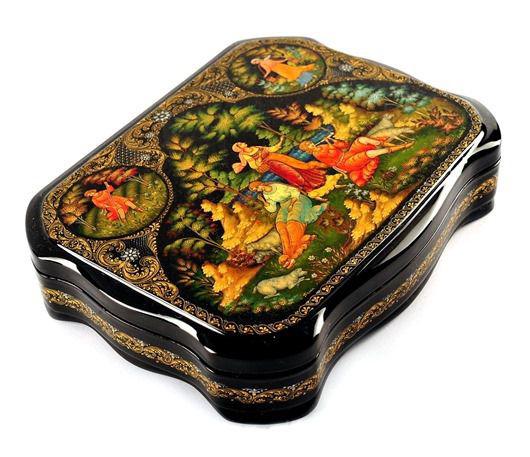
In the 60 years of XVIII century gunsmith Fedor Lisitsyn decided to organize in Tula enterprise for the production of pots and "devices for heating the water." Soon, no fair is held without the participation of the articles of Tula craftsmen. By Oke "handsome pot-bellied" slithered across Russia. Interestingly, the price of the product was determined by its weight. Despite the variety of shapes and design, all the samovar had the same device - wall pan, pitcher, faucet handles. Often in the manufacture of a samovar involved the whole family - thus the senior masters shared their experience and knowledge minor.
In 1829, at the St. Petersburg exhibition Tula samovar was awarded a small silver medal. Today Tula samovars not only an indispensable attribute of Russian tea, and original works of art, Tula glorified not only in his native country, but also far beyond its borders.
--img9--
Shemogodskaya trench elm
--img10--
Unusual warmth filled with products from birch bark masters Vologda. Popularity bark of our ancestors is not accidental - it is very light, durable and durable material. Manufactured from birch bark utensils, baskets, tuesa, boxes, jewelry, clothes and shoes. The greatest popularity has received shemogodskaya trench elm, which received its name from the river Shemoksy that flows below the Great Ustyug Vologda. Openwork floral ornament, intricately twisted stems, flowers, leaves and berries - it makes traditional pattern lace Veliky birchbark inimitable.
--img11--
Khokhloma painting
--img12--
Probably Khokhloma painting appeared in the XVII century in village Khokhloma, on the left bank of the Volga. However, there is a large number of other versions of the appearance of this ancient folk art. Traditional juicy berries of mountain ash in the gilded leaves on a black background are unlikely to leave indifferent. Later, with floral motifs were added to the image of birds, fish and animals. This type of decorative painting was used for decoration of dishes and furniture. Cups, bowls, bochata, and, of course, wooden spoons - are just a small part of the range with Khokhloma painting.
Khokhloma products valued not only for their beauty but also for the wonderful practicality. In this dish, and you can file a hodgepodge and bring tea, and do not worry about faded paint or varnish crack. Today is considered the birthplace of khokhloma Kovernino village of Nizhny Novgorod. Khokhloma painting - a unique phenomenon, not only for Russia but also for the world of art.
--img13--
Palekh boxes
--img14--
The small town of Palekh in the Ivanovo region has long been famous for icon painting. Ever since the Mongol-Tatar yoke great demand small icons "pysanka", which could be easily hidden. In the middle of the XVII century Palekh came to work in Moscow, and craftsmen were invited to work - the Palace of Facets in the Kremlin, the Trinity-Sergius Lavra, Novodevichy monastery were decorated by Palekh icons. In XX century, Palekh masters are forced to change the direction of their work story - a fairy tale Pushkin, scenes of rural life, the revolutionary motives. At this time the gang is created that carries lacquer painting on papier-mache. Fine work Palekh - cigarette cases and brooches, boxes and notebooks, caskets and casket famous - are known throughout the world.
--img15--
Source:

Dymkovo toy

Bright and elegant Dymkovo toy became a symbol of Vyatka land. This is one of the oldest Russian crafts, which are engaged in Vyatskie master has for 400 years. The emergence of toys associated with the spring holiday to Whistler when out of the hands of women Dymkovo settlement out of clay whistles in the form of a sheep, konyashek, goats or ducks.
In 30-ies of XX century there was not only a large number of variations on the theme of spring toys and household fairy stories, but we developed a lot of new patterns and color combinations. Each toy - is unique and unique, because it molded and sign master each time. In the analog world, this clay there is no miracle.

Orenburg shawl

This thing is unmatched fit and goat fluff of cotton, silk or other filaments that make up its foundation. Knit from down in Orenburg began in the XVIII century. Abroad, the first Orenburg shawl was presented in 1857 at the Paris International Exhibition. Beauty and grace conquered the European audience.
The French in XVIII-XIX century, tens of thousands of pounds of imported Orenburg down, which is raised above Kashmir. Shawl, "spider" and stole - the three main varieties of Orenburg shawls. The main criteria of quality - a scarf should pass through the ring and placed in a goose egg. Top "webs" Today knit villages Shishma and Yellow Saraktash area.

Ural malachite

Despite the fact that malachite mined not only in the Urals, this green mineral with unique design is considered "Russian" rock, because that's Ural malachite superior to the others in its grandeur, "on the surface, like velvet, and a break as an atlas." From the Urals went and common throughout the world stone processing machines, called "Russian Mosaic". Loved present malachite product and Russian tsars. So, Napoleon, Alexander I gave the table a vase and candelabra, izgotovlnyee malachite. Unfortunately, in the Urals almost no true masters, able to create masterpieces, like vases and Galberga Shtakenshnejdera, tabletops Montferrand or malachite columns Bryullova.

Tula samovar

In the 60 years of XVIII century gunsmith Fedor Lisitsyn decided to organize in Tula enterprise for the production of pots and "devices for heating the water." Soon, no fair is held without the participation of the articles of Tula craftsmen. By Oke "handsome pot-bellied" slithered across Russia. Interestingly, the price of the product was determined by its weight. Despite the variety of shapes and design, all the samovar had the same device - wall pan, pitcher, faucet handles. Often in the manufacture of a samovar involved the whole family - thus the senior masters shared their experience and knowledge minor.
In 1829, at the St. Petersburg exhibition Tula samovar was awarded a small silver medal. Today Tula samovars not only an indispensable attribute of Russian tea, and original works of art, Tula glorified not only in his native country, but also far beyond its borders.
--img9--
Shemogodskaya trench elm
--img10--
Unusual warmth filled with products from birch bark masters Vologda. Popularity bark of our ancestors is not accidental - it is very light, durable and durable material. Manufactured from birch bark utensils, baskets, tuesa, boxes, jewelry, clothes and shoes. The greatest popularity has received shemogodskaya trench elm, which received its name from the river Shemoksy that flows below the Great Ustyug Vologda. Openwork floral ornament, intricately twisted stems, flowers, leaves and berries - it makes traditional pattern lace Veliky birchbark inimitable.
--img11--
Khokhloma painting
--img12--
Probably Khokhloma painting appeared in the XVII century in village Khokhloma, on the left bank of the Volga. However, there is a large number of other versions of the appearance of this ancient folk art. Traditional juicy berries of mountain ash in the gilded leaves on a black background are unlikely to leave indifferent. Later, with floral motifs were added to the image of birds, fish and animals. This type of decorative painting was used for decoration of dishes and furniture. Cups, bowls, bochata, and, of course, wooden spoons - are just a small part of the range with Khokhloma painting.
Khokhloma products valued not only for their beauty but also for the wonderful practicality. In this dish, and you can file a hodgepodge and bring tea, and do not worry about faded paint or varnish crack. Today is considered the birthplace of khokhloma Kovernino village of Nizhny Novgorod. Khokhloma painting - a unique phenomenon, not only for Russia but also for the world of art.
--img13--
Palekh boxes
--img14--
The small town of Palekh in the Ivanovo region has long been famous for icon painting. Ever since the Mongol-Tatar yoke great demand small icons "pysanka", which could be easily hidden. In the middle of the XVII century Palekh came to work in Moscow, and craftsmen were invited to work - the Palace of Facets in the Kremlin, the Trinity-Sergius Lavra, Novodevichy monastery were decorated by Palekh icons. In XX century, Palekh masters are forced to change the direction of their work story - a fairy tale Pushkin, scenes of rural life, the revolutionary motives. At this time the gang is created that carries lacquer painting on papier-mache. Fine work Palekh - cigarette cases and brooches, boxes and notebooks, caskets and casket famous - are known throughout the world.
--img15--
Source:
